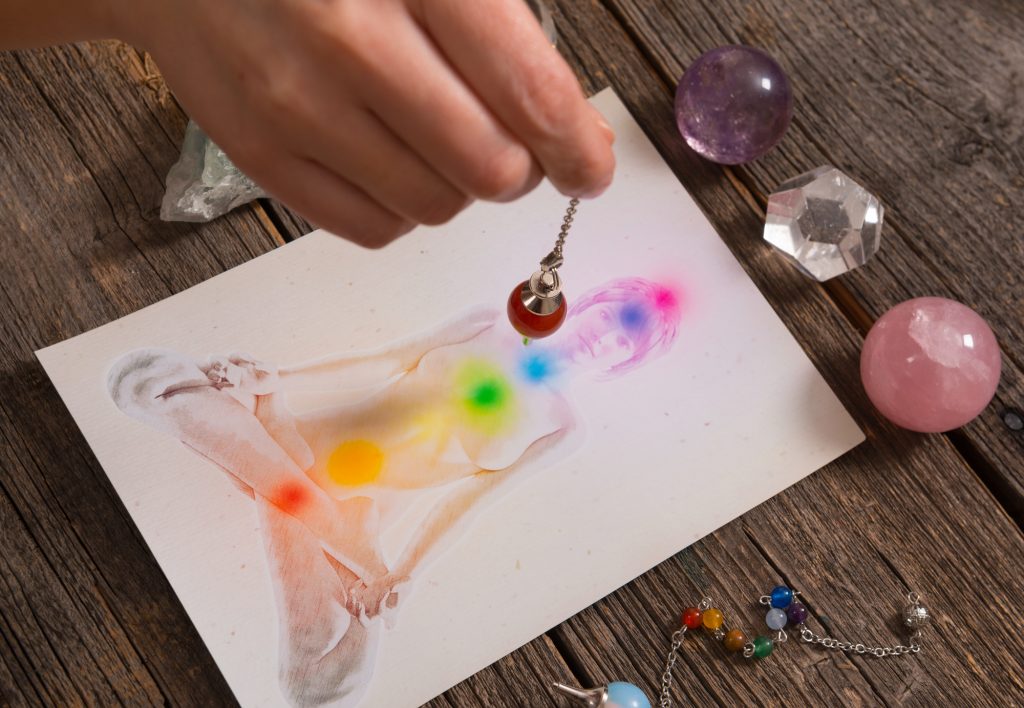Dual rod and Radiesthesy: the power of the divinatory pendulums

We have already wrote here about Radiesthesy and, as we saw, this is a practice in which the seeker employs a swinging pendulum or a dual rod to find a lost or hidden object, to foretell the future or to request guidance from the spiritual world.
The term itself was not coined until 1927, when the French priest Alex Bouly created the neologism by combining the Latin words for “radiation” and “perception”. Bouly also founded of the Society of Friends of Radiesthesy, and then six years later Col. A H Bell formed the British Society of Dowsers. The UK dowsing organization remains active to this very day.
Receive all our tips by email!
Love Astrology? Subscribe Now and Receive Exclusive Content!
By definition, Radiesthesy or Radiesthesia is a sensitiveness held to enable a person with the aid of a divining rod or pendulum to detect things. It’s closely related to the more well-known dowsing, defined as a technique for searching for underground water, minerals, or anything invisible, by observing the motion of a pointer or the changes in direction of a pendulum.
There are two types of dowsing:
- Physical dowsing: dowsing, hydroscopy, geobiology, mineralogy;
- Divinatory dowsing: search for missing persons, questioning of the unconscious, personal or collective.
In this article we are going to focus on divinatory dowsing, since it is a way to communicate with the part in us that is connected to knowledge, silent knowledge, and most of the time subconscious knowledge.
Dual rod and Radiesthesy: how does it work?

There is not a consensus about the way dual rod and pendulum works. Some hold that the action of the pendulum or dowsing rod is driven by spirits. Others say the pendulum responds to energy fields emitted by all living things. And still, others insist the pendulum responds to subtle, involuntary muscle movements and, therefore, reflects the subconscious will.
Despite the opinions, we believe that Radiesthesia sessions can be quite instructive for those who approach them with a curious and open mind.
We’ve said before that divinatory dowsing is a way to communicate with the part in us that is connected to knowledge. However, to become aware of this knowledge we need to practice and learn to listen to our intuition, sensations, and inner voice. This is because our body receives endless information all the time, and, most of the time, we are not aware of it. Thus, dowsing is a technique that enables us to become aware of the information our body receives.
We have to ask to the body precise questions that can be answered by “yes” or “no” and we can read the answer on the tool. Since there are several Radiesthesy techniques (as there are dowsers), when you start to practice you will develop, over time, your own way to receive and translate information.
Some people use a pendulum, a stick, a dual rod and some do it deviceless. For the beginners, the pendulum is, probably, the best way to learn.
Dowsing practice: how to do it?
Normally, the dual rod measures energy fields, reason why some people use them to find (gold, silver, copper) objects, water or simply to identify energy levels in their bodies (mainly on chakras). Despite some beliefs, you do not need powerful bio-energy or extrasensory perceptions to work with the dual rod. To the instrument work in your hands, the essential condition is to master the balance of the device.
In order to get this skill you should practice for a very long period (at least a couple of weeks). What you should strive to achieve is a very smooth motion of the antenna in the horizontal plain, without any trembling or false mental reactions.
Our advice is to lower the front end of the antenna slightly until you master the balance. You have to achieve a motion around 90 degrees for about four or five seconds. Since the balance is easier to achieve with a double handle (that is why you are using a dual-rod), your hands should be held tightly to your body, while the spinning movement of the device in the plain is produced by the waist.

What about the pendulum?
The first thing to find out is the pendulum’s movement that means “yes” and the one that means “no”, since they are different for each person.
Try this exercise: hold your pendulum between thumb and index of the hand you feel more comfortable with. Don’t forget to relax shoulders and arms. Then, hold your pendulum above the palm of your other hand. Wait to see which movement the pendulum does. You can give it a back and forth starting swing or hold it still. The movement of the pendulum above the palm of your hand means “yes”. Then turn your hand and hold the pendulum above the back side of your hand, the movement that shows up means “no”.
The second exercise is to ask your intimate questions, but you need to phrase them precisely. This is, clear and simple questions that can only be answered by “yes” or “no”. Then practice as much as you can, until you become confident about the answers you get.
Important note
When the dual rod or the pendulum acts weird – for example, doesn’t show the usual “yes-no” movements – it needs to be de-charged. Keep in mind that these instruments get charged with energies when you use it. For example, in the pendulum’s case it needs to be washed with streaming water from time to time.
You may also like:
- Hypnosis: everything you need to know
- Ericksonian hypnosis: all you need to know
- Reiki: everything you need to know
- Chiropractic: everything you need to know

